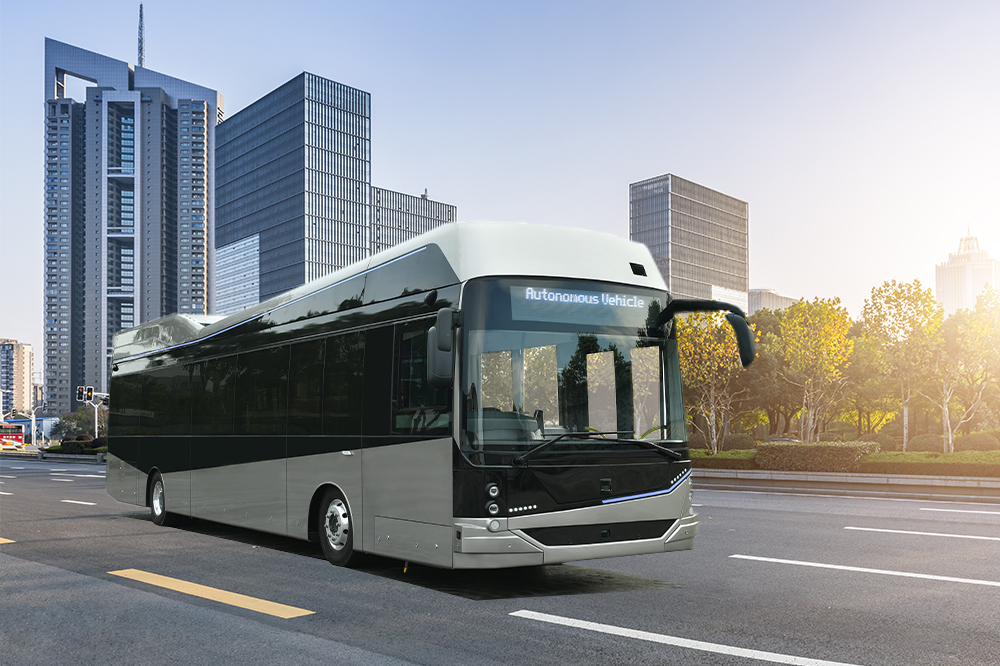With increasing urbanisation, the efficiency of a city’s transport system has become more important. Shared autonomous transport could be the answer to pave the way towards more connected, sustainable and safer modes of transport for cities worldwide. Singapore, along with the rest of the world, has been developing and testing AV technologies with the aim of establishing new use cases to benefit communities. Key benefits include
– Enhance Connectivity: serve first/last mile commutes, low demand areas and on-demand basis
– Improve Safety: utilise technologies to ensure stringent safety adherence during operation
– Drive Sustainability: reduce wasted bus trips and the number of private vehicles on the road
On the way to work on a typical morning, you whip out your phone and press a few buttons. Within moments, you board an autonomous bus and arrive at your workplace within 20 minutes.
Convenient and comfortable commutes, with on-demand functions that do not require any human interaction. This vision of easily accessible mobility is within grasp, thanks to the developing capabilities of autonomous vehicles, or AVs, that are currently being tested and refined for smoother travels.
While driverless cars are often in the limelight, shared autonomous shuttles and buses are fast gaining traction, with increasing trials to ensure they are city-ready and effective in overcoming transportation challenges. The higher passenger capacity of shared autonomous transport is key to enabling a more efficient and sustainable transportation model that addresses mobility pain points in cities.
In Singapore, shared and autonomous mobility is a key part of the country’s master plan for land transport to solve current and future urban mobility challenges. Today, mid-and full-sized autonomous bus services have already started providing revenue service for the public at the Singapore Science Park 2 and Jurong Island1, adding to its portfolio of smaller-sized autonomous shuttles around the country. This paves the way for more potential value propositions of AV deployments in the country, with supporting regulations accompanied by large swathes of testbed areas set aside for testing AVs2 under a wide range of real-world traffic scenarios.

Similarly, countries like China, South Korea and Japan have also begun testing autonomous shuttles. China has passed new laws to ensure safety on its highways3; South Korea has planned to test autonomous buses in the administrative hub of Sejong to increase ridership and assist those who are physically handicapped4; and Japan is testing autonomous buses to help the elderly get around rural areas5.
Autonomous vehicles revolutionise urban mobility by making it more accessible, affordable and, more importantly, environment-friendly. If they are well integrated into the public transport system, AVs will transform the mobility landscape and encourage more people to make the shift from private vehicles to public transport.
Here are three key benefits of autonomous buses:
One of the key goals of the public transportation system is to increase connectivity, including intra-cities and first/last mile commutes. It is especially important in large and dense cities, where most residents depend on public transport to get around.
This is where the role of autonomous shuttles will be most beneficial. They help to increase the frequency of public buses travelling on fixed routes. Besides plying fixed routes, autonomous shuttles also hold the potential for dynamic routing by offering various transport services and applications through the Autonomous Shuttles-as-a-Service (ASaaS) model.
The on-demand service can be an optimal mode of transportation in areas that are not traditionally served by public buses to extend the reach of public transportation. AVs are also able to function round-the-clock, as they have low to no downtime. This helps to improve accessibility by complementing the current public transport network and enhancing the transport infrastructure connectivity of cities worldwide.
Safety is of utmost concern in transportation. As AVs go through rigorous rounds of testing and global safety standards are being set to ensure safer navigation, studies have shown that AVs are more likely to improve than worsen safety on the road. The simple reason is that AVs can greatly reduce the risk of human error, which is one of the key causes of road accidents. According to a comprehensive study on road safety, human error was the sole cause in 57% of all accidents and contributed to over 90% of these accidents.
With artificial intelligence (AI), analytics, advanced algorithms, sensors and various AV technologies deployed to ensure stringent safety adherence during operation, AVs are more likely to reduce the number of vehicle-related injuries and accidents. The improved road safety could also lead to a more efficient and optimised land transport ecosystem with fewer congestions and disruptions caused by road accidents.
Autonomous buses are likely to pave the way for more sustainable urban transportation.
On-demand autonomous shuttles can be booked in advance or when needed. It reduces unnecessary trips carried out by fixed-route buses or buses that serve low-demand areas. The demand and supply of public transport services are better matched to optimise limited transport resources.
With connected vehicle technology that enables more informed driving, autonomous shuttles could communicate with the surrounding environment through infrastructures and other vehicles for smoother driving, without frequently braking and accelerating. This can reduce carbon emissions due to unnecessary idling on the road and delays caused by traffic accidents.
These are just some scenarios of how autonomous buses can reduce wasted bus trips and the number of private vehicles on the road, making these buses a more environmentally-friendly transport option for cities. In the long term, this will also help cities achieve economies of scale from the shared use of infrastructure and services.
Although shared AVs do not put an end to a city’s congestion and pollution woes, they promise a more efficient transportation solution with better accessibility and greater convenience for commuters. They potentially hold the key to safer roads and eventually pave the way for a car-lite community, transforming the way we travel and live.
Learn more about ST Engineering Autonomous Transport Solutions